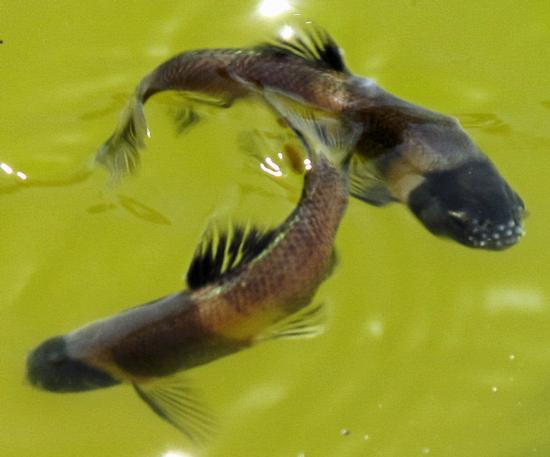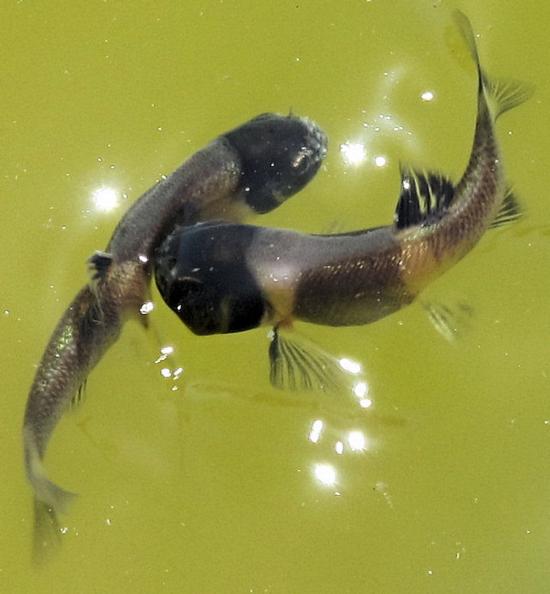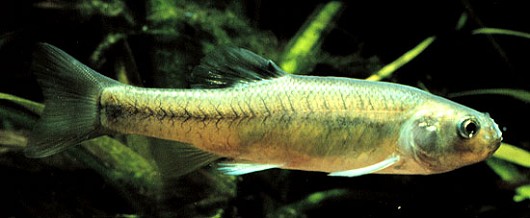Fathead minnow
-
Scientific NamePimephales promelas
-
NativeNo
-
Identification
 Fathead minnow, males in breeding colors. Location: Pond in mountains above Anza, CA. Date: 2012. Photo by Michael McGrady. Note tubercles on snout.
Fathead minnow, males in breeding colors. Location: Pond in mountains above Anza, CA. Date: 2012. Photo by Michael McGrady. Note tubercles on snout. Fathead minnow, males in breeding colors. Location: Pond in mountains above Anza, CA. Date: 2012. Photo by Michael McGrady. Note 2 pale vertical bars.
Fathead minnow, males in breeding colors. Location: Pond in mountains above Anza, CA. Date: 2012. Photo by Michael McGrady. Note 2 pale vertical bars. Fathead minnow. Photo by Konrad Schmidt, Nongame Fish Biologist, Division of Ecological Services, Minnesota Department of Natural Resources.
Fathead minnow. Photo by Konrad Schmidt, Nongame Fish Biologist, Division of Ecological Services, Minnesota Department of Natural Resources.- Chunky body with an oblique mouth and a crowding of scales behind the head
- Head is short, blunt, and broad on top
- Breeding males have conspicuous tubercles on the snout, chin, and pectoral fins and a spongy pad on the back of the head
- Dark brown or olive back, with dull and dusky sides, often with black peritoneum showing through
- Scales are outlined in pigment on the back
- Breeding males turn completely black except for two wide, pale, vertical stripes on their sides.
- Small fish or fish from turbid waters may be pale whitish to silvery
- 8 dorsal, 8 pelvic, and 7 anal fin rays
- First dorsal fin is thickened
- 44-54 scales in the lateral line which rarely extends beyond the anterior half of the body
-
Life History
The fathead minnow is a species that thrives in areas where other fish have trouble establishing. Fathead minnows can withstand alkalinities higher than 2,100 mg/L, dissolved oxygen levels lower than 1 mg/L and temperatures between 7°C and 33°C. Most commonly this means fathead minnows settle in pools of small, muddy streams or in ponds with limited interspecific competition but they can also excel in intermittent streams, vernal pools, and other temporary water bodies. To endure these harsh environments, fathead minnows are very opportunistic eaters, taking whatever filamentous algae, diatoms, small invertebrates, and even loose organic matter they can find on the bottom using their long intestine and grinding teeth to digest the difficult materials. In areas where predation is a risk fathead minnows will stay close to aquatic vegetation beds and use their strong sense of smell to detect potential threats.
Spawning age is quite variable, but in California an individual’s first summer, when temperatures are between 15°C and 32°C, is a common maturing point. Males are territorial, aggressively defending and carefully cleaning a submerged board, stone, root mass, old tire, or any other surface that eggs can be hung underneath. Interestingly, the same head pad that males use to clean the nest surface is also used to secrete a mucus on the developing embryos that is believed to improve the young’s chances of survival. Once males have established their territories, females will leave their school to judge the male’s nest and courtship display. If the male is successful the female will attach her adhesive eggs to the underside of the nest object where the male will then fertilize them. Females can hold 600-2,300 in their body at once but at any given time only a third of those eggs will be ripe. Fathead minnows mate multiple times throughout the summer however, and females will potentially lay more than 4,100 eggs by the end of the season. Both sexes have several partners during the spawning season leading to nest sites that have more than 12,000 embryos in various stages of development under a single male’s care. Eggs hatch 4-6 days later at 25°C and the 4.8 mm-long larvae will stay under the nest for several more days after hatching. Their growth will be influenced by a variety of factors, including population size, temperature, and food availability, but in general they will reach 84 mm in length by the end of one year. Most do not live past this age and adults usually die within 30-60 days of spawning. The maximum age and length recorded is 3 years and 109 mm respectively.
-
Links to Other ResearchN / A


